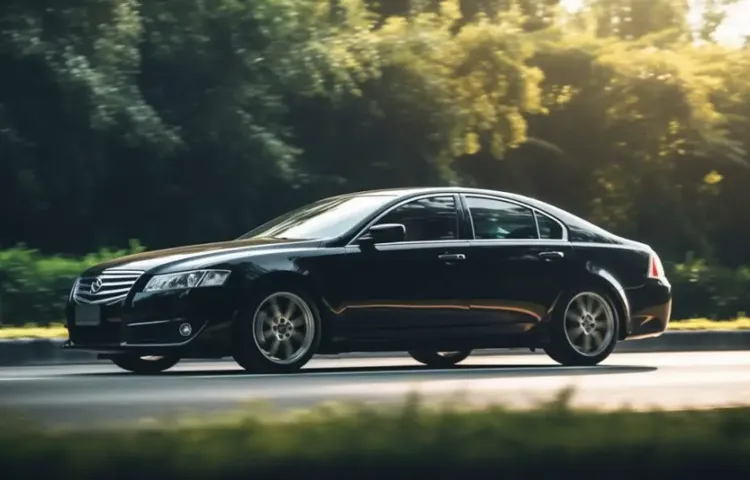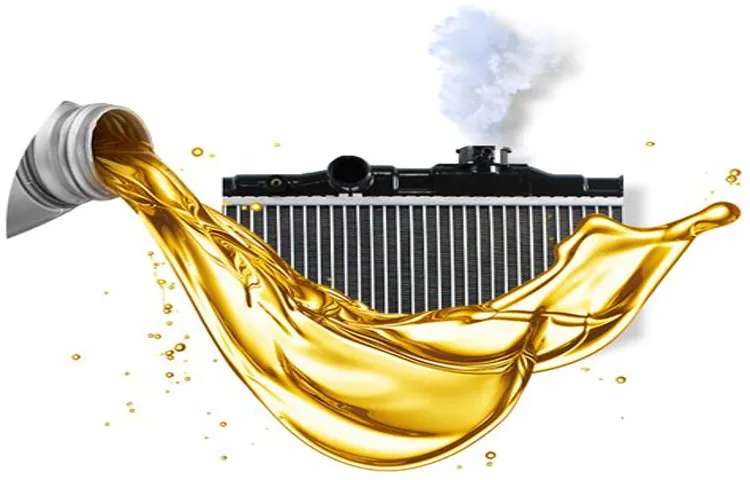Have you ever checked your car’s coolant and noticed that it looks brown instead of its usual vibrant color? It can be quite alarming and leave you wondering what could be causing this discoloration. After all, coolant is supposed to keep your engine running smoothly and protect it from overheating. So, why does your coolant look brown? Let’s dive in and unravel this mystery together! Think of coolant as your car’s lifeline, similar to how blood is essential for our bodies.
It flows through the engine, absorbing heat and preventing it from overheating. Coolant typically has a bright color, like green or pink, which makes it easy to spot any abnormalities. However, when it turns brown, it’s a clear indication that something isn’t quite right.
One possible reason for brown coolant is the presence of rust or sediment. Over time, the metal components in your car’s cooling system can corrode, leading to the formation of rust. This rust mixes with the coolant and gives it a brownish hue.
Similarly, sediment from dirt, debris, or old coolant can accumulate in the system and cause discoloration. Another culprit could be a leaking engine gasket or a cracked cylinder head. When these parts fail, coolant can mix with the engine oil, resulting in a brown sludge-like substance.
This is a serious issue that requires immediate attention, as it can lead to engine damage if left unresolved. Additionally, brown coolant may indicate a problem with the radiator or heater core. Both of these components play a crucial role in regulating the temperature of the coolant.
If they are clogged or damaged, it can cause the coolant to become contaminated, leading to the brown color. In some cases, a coolant additive or sealant can also cause the coolant to turn brown. These products are often used to repair minor leaks, but they can react with the existing coolant, discoloring it in the process.
Table of Contents
Introduction
Have you ever noticed that your coolant has a brownish hue? If so, you may be wondering why your coolant is not the usual bright green or orange color. Well, there are a few reasons why your coolant might appear brown. One possibility is that your coolant is simply old and needs to be changed.
Over time, coolant can degrade and become contaminated with dirt, rust, and other particles, causing it to turn brown. Another reason could be a leaking gasket or seal in your engine, which can allow oil to mix with the coolant and give it a brownish tint. Lastly, if your coolant is mixed with rust or sediment from your engine, it can also result in a brown color.
Regardless of the reason, it’s important to address this issue as soon as possible. Brown coolant may not provide the necessary protection for your engine and could lead to overheating or other mechanical problems.
Explanation of Coolant
coolant, engine cooling system, overheating problems, antifreeze, coolant mixture Introduction: Have you ever wondered how your car’s engine manages to stay cool even during long drives? Well, the secret lies in the coolant. Coolant is a vital component of your car’s engine cooling system, which helps to regulate its temperature and prevent overheating problems. It is commonly known as antifreeze and is made up of a mixture of water and chemicals.
But what exactly does coolant do and why is it important? Let’s dive deeper into the world of coolant and uncover its secrets.

Importance of Maintaining Coolant
coolant maintenance Introduction: Maintaining coolant is an essential aspect of keeping your vehicle in perfect working condition. Coolant, also known as antifreeze, plays a crucial role in regulating the temperature of your engine. It prevents overheating and freezing, ensuring that your vehicle’s engine runs smoothly.
Neglecting coolant maintenance can lead to serious and costly damage to your engine. So, let’s dive into why maintaining coolant is so important and how you can ensure its proper care.
Possible Causes of Brown Coolant
If your coolant looks brown, it could be a sign of a potential problem with your vehicle’s cooling system. There are a few possible causes for brown coolant, and it’s important to address them promptly to avoid any further damage. One possible cause is the presence of rust in the cooling system.
Over time, corrosion can occur in the radiator and other components, causing the coolant to become discolored. Another possible cause is an issue with the head gasket. If the head gasket is damaged, it can allow oil to mix with the coolant, resulting in a brownish color.
Lastly, an overheating engine can cause the coolant to turn brown. When the engine overheats, the coolant can break down and oxidize, leading to discoloration. If you notice brown coolant in your vehicle, it’s recommended to have it inspected by a mechanic to determine the cause and address any necessary repairs.
Rust and Corrosion
rust and corrosion, brown coolant, possible causes
Oil Contamination
coolant, oil contamination, brown coolant, causes of brown coolant. Brown coolant in a vehicle’s cooling system can be a cause for concern, as it often indicates the presence of oil contamination. But what causes this oil contamination in the coolant? There are a few possible reasons.
One of the most common causes is a leaking head gasket. The head gasket sits between the engine block and the cylinder head, sealing the combustion chambers and allowing coolant and oil to flow through their respective channels. If the head gasket becomes damaged or worn, it can lead to a leak, allowing oil to mix with the coolant.
Another potential cause of oil contamination is a cracked engine block or cylinder head. This can occur due to overheating or physical damage, causing a rupture in the metal surface and allowing oil and coolant to mix. Additionally, a failing oil cooler can also be a culprit.
The oil cooler is responsible for cooling down the engine oil, and if it develops a leak, oil can seep into the coolant. Lastly, a faulty transmission cooler can also lead to oil contamination in the coolant. The transmission cooler is responsible for cooling the transmission fluid, and if it fails, transmission fluid can mix with the coolant.
Overall, it’s important to address the issue of oil contamination in the coolant promptly, as it can lead to engine damage if left untreated.
Coolant Additives
“brown coolant”
Effects of Brown Coolant
If you’re wondering why your coolant looks brown, there could be a few reasons behind it. One possibility is that your coolant has become contaminated with rust or corrosion. Over time, the metal parts in your engine can start to break down and release tiny particles of rust or other debris.
This can mix with your coolant and give it a brown or muddy appearance. Another reason could be that your coolant is old and needs to be replaced. Coolant can break down and lose its effectiveness over time, especially if it’s been subjected to extreme temperatures or hasn’t been properly maintained.
If your coolant is brown, it’s a good idea to have it checked by a professional to determine the cause and make any necessary repairs or replacements.
Decreased Cooling Efficiency
brown coolant, decreased cooling efficiency, effects, engine temperature, overheating, corrosion, rust, cooling system, components, radiator, water pump, thermostat, coolant passages, diminished heat transfer, engine performance, damage, seals, gaskets, blocked passages, breakdown, expensive repairs Did you know that using brown coolant in your vehicle’s cooling system can lead to decreased cooling efficiency? While it may not seem like a big deal, the color of your coolant actually plays an important role in maintaining your engine’s temperature. Brown coolant, which is usually a sign of old and oxidized coolant, can cause a number of problems that can lead to engine overheating and damage. One of the main effects of brown coolant is corrosion and rust.
Over time, the brown coolant can cause corrosion and rust to build up in your cooling system, including your radiator, water pump, thermostat, and coolant passages. This can result in diminished heat transfer and a decrease in overall cooling efficiency. As a result, your engine may run hotter than usual, leading to reduced engine performance and potentially even engine damage.
Additionally, the corrosion and rust caused by brown coolant can also damage seals and gaskets in your cooling system, leading to leaks and blocked passages. This can further reduce the efficiency of your cooling system and increase the risk of overheating. Ultimately, using brown coolant can lead to expensive repairs and breakdowns if not addressed promptly.
So, make sure to regularly inspect your coolant and flush it out if it starts to turn brown.
Damage to Engine Components
brown coolant, damage to engine components, effects
What to Do If Your Coolant is Brown
If you notice that your coolant is brown, it can be a sign of a potential problem with your vehicle. Coolant is typically a bright green or orange color, and a brown color can indicate the presence of rust, sediment, or oil in the coolant system. This can be caused by a number of things, such as a leak in the radiator or heater core, a faulty gasket, or a failing water pump.
It’s important to address this issue promptly, as brown coolant can lead to overheating, engine damage, and other costly repairs. Taking your car to a mechanic for a coolant flush and inspection can help identify the source of the problem and determine the best course of action.
Flush and Replace Coolant
“brown coolant,” “flush coolant,” “replace coolant” What to Do If Your Coolant is Brown If you’ve noticed that your coolant has turned brown, it’s important to take action right away. Brown coolant can indicate a problem with your cooling system, and ignoring it could lead to serious engine damage. So, what should you do if you find yourself in this situation? First, you’ll want to flush and replace the coolant.
Flushing the system will help remove any contaminants and debris that may be causing the discoloration. To do this, you can drain the old coolant from the radiator and then fill it up with a mixture of fresh coolant and water. Make sure to follow the manufacturer’s recommendations for the correct coolant-to-water ratio.
Next, you’ll want to inspect the cooling system for any leaks or other issues that may have caused the coolant to become contaminated. This could include checking the radiator, hoses, thermostat, and water pump for any signs of damage or wear. If you’re not comfortable performing these inspections yourself, it’s best to bring your vehicle to a qualified mechanic who can do a thorough check for you.
Once any necessary repairs have been made, it’s important to monitor the coolant regularly to ensure that it stays clean and free of any contaminants. Regular maintenance, such as checking the coolant level and topping it off as needed, will help prevent any future issues. In conclusion, if your coolant has turned brown, don’t ignore it.
Flushing and replacing the coolant, inspecting the cooling system for any issues, and performing regular maintenance will help keep your engine running smoothly and prevent any potential damage. So, take action today and keep your coolant clean and clear!
Inspect for Leaks or Other Issues
brown coolant, inspect for leaks, coolant issues
Regular Coolant Maintenance
brown coolant, regular coolant maintenance If you’ve been keeping up with regular coolant maintenance, it’s unusual to see your coolant turn brown. Coolant is typically a bright green or orange color, so brown coolant can be a sign of a problem. But what exactly does it mean and what should you do if you find yourself in this situation? Brown coolant can indicate the presence of rust or contaminants in your cooling system.
Over time, these particles can build up and cause the coolant to change color. This can happen due to old or dirty coolant, or it might be a sign of a larger issue with your engine. Either way, it’s important not to ignore it.
First, check your coolant level. Low coolant levels can lead to overheating and other engine problems. If you notice that your coolant level is low, top it off with a 50/50 mixture of coolant and water.
Be sure to use the type of coolant recommended by your vehicle’s manufacturer. Next, consider flushing your cooling system. Flushing involves draining the old coolant, flushing out any debris or contaminants, and then refilling with fresh coolant.
This can help remove any built-up rust or contaminants and prevent further damage to your engine. If flushing the system doesn’t solve the problem, it’s time to consult a professional. They can perform a more thorough inspection of your cooling system and determine if there are any underlying issues that need to be addressed.
It’s always better to be safe than sorry when it comes to your vehicle’s engine. In conclusion, brown coolant is not something to ignore. It can indicate a problem with your cooling system or engine, so it’s important to take action.
Conclusion
It appears that your coolant has taken a walk on the wild side and transformed into a bold and beautiful shade of brown. While this color may be visually captivating, it unfortunately suggests some foul play is at hand within your cooling system. The most common reason for brown coolant is contamination.
It could be caused by a mischievous mixture of rust, dirt, or even oil. Like a band of mischief-makers, these particles find their way into your coolant and taint its once pristine hue. Rust, being the party crasher that it is, can infiltrate your cooling system through old, corroded pipes or a worn-out radiator.
It then uses its rusty charm to turn your coolant a lovely shade of brown. Dirt is like a sneaky spy, lurking in the shadows and waiting for the perfect opportunity to strike. It can find its way into your coolant through dirty reservoirs or neglected maintenance.
Once inside, it mingles with your coolant, giving it its unique brown color. And then we have the oil, the resident troublemaker. Sometimes, due to a leak or a faulty gasket, oil can sneak its way into your cooling system.
Once there, it mixes and mingles with your coolant, causing it to lose its clear complexion and adopt a more rebellious brown shade. So, dear coolant owner, do not fret. A quick visit to your trusted mechanic, armed with this knowledge, will help identify the culprit behind your brown coolant.
With their expertise and a little bit of detective work, your coolant can be restored to its former glory, ready to take on the road ahead. Just remember, sometimes a little mystery adds excitement to our daily drives!”
FAQs
Why does my coolant look brown?
Brown coolant can indicate a potential problem with your cooling system, such as the presence of rust, sediment, or oil contamination. It is recommended to have your coolant system inspected and flushed to prevent any further damage or overheating.
Can contaminated coolant cause engine damage?
Yes, contaminated coolant can lead to engine damage. Rust particles, sediment, or oil contamination can clog the cooling system, leading to poor heat transfer and potential overheating of the engine. It is important to address any coolant contamination issues promptly.
How often should I check and replace my coolant?
It is generally recommended to check your coolant levels every 3-6 months and replace your coolant every 2-3 years. However, it is best to consult your vehicle’s owner’s manual or contact a professional mechanic for specific recommendations based on your vehicle’s make and model.
What are the signs of coolant contamination?
Signs of coolant contamination can include a change in color (such as brown or milky appearance), a foul odor coming from the coolant, overheating issues, or a decrease in coolant levels. If you notice any of these signs, it is advisable to have your cooling system inspected.
Can I mix different types of coolant?
It is generally not recommended to mix different types of coolant, as they may have incompatible additives or chemical compositions. Mixing coolants can lead to reduced corrosion protection, decreased coolant effectiveness, and potential damage to your cooling system. Always consult your vehicle’s manual or a professional mechanic for guidance on using the correct type of coolant for your vehicle.
How can I prevent coolant contamination?
To prevent coolant contamination, ensure that your cooling system is properly maintained, including regular coolant changes, using the recommended coolant for your vehicle, and addressing any issues promptly. Avoid mixing different types of coolant and make sure to check for any signs of coolant leakage or contamination regularly.
Can a coolant flush solve coolant contamination issues?
A coolant flush can help remove contaminants from the cooling system and restore the coolant’s effectiveness. However, it may not be sufficient if there is significant damage or contamination. It is best to have a professional mechanic assess the extent of the contamination and recommend appropriate actions, which may include a coolant flush or other repairs.



